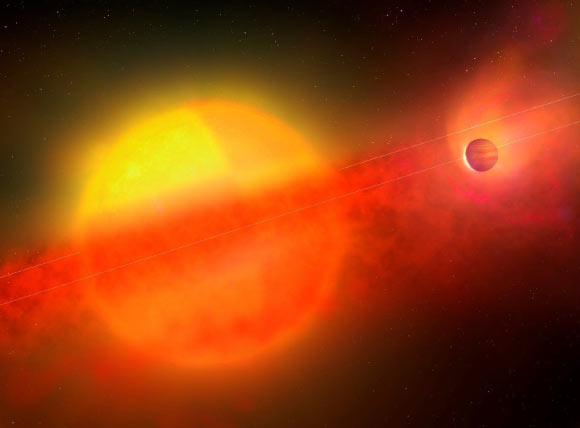Astronomers Discover Three Compact Planetary Systems | Astronomy – Sci-News.com
Astronomers from the Dispersed Matter Planet Project (DMPP) have discovered three new planetary systems — designated DMPP-1, 2 and 3 — hosting six short-period exoplanets. These planets orbit very close to their parent stars and have surface temperatures between 1,100 and 1,800 degrees Celsius (2,012-3,272 degrees Fahrenheit).

An artist’s impression of the giant exoplanet DMPP-2b and its parent star DMPP-2. Image credit: Mark A. Garlick.
“These new discoveries are very promising for further studies,” said Professor Carole Haswell, head of astronomy at the Open University and principal investigator of the DMPP project.
“They should allow us to measure the relationships between the mass, size and composition of planets outside our own Solar System.”
DMPP-1 is a 2-billion-year-old F8V-type star located about 204 light-years away.
Also known as HD 38677, it hosts a compact planetary system with orbital periods of 2.9-19 days, comprising four massive planets: DMPP-1b, c, d and e.
DMPP-1c, d and e are super-Earth planets with masses between 3 and 10 that of Earth. DMPP-1b is a Neptune-like planet with a mass about 24 Earth masses.
“DMPP-1 hosts a really important planetary system with three low mass exoplanets whose composition we can measure,” said Dr. Daniel Staab, an astronomer in the School of Physical Sciences at the Open University and the Rutherford Appleton Laboratory.
DMPP-2, otherwise known as HD 11231, is a 2-billion-year-old F5V-type star approximately 452 light-years from Earth.
Its only known planet, DMPP-2b, is a close orbiting giant planet with a mass almost half that of Jupiter in a 5.2-day orbit.
DMPP-3, also known as HD 42936, is a 6-billion-year-old binary stellar system at a distance of about 153 light-years.
The primary star in the binary system, DMPP-3A, is a slowly rotating K0V-type star.
It hosts a super-Earth planet in a 6.7-day orbit, DMPP-3Ab, and has a stellar companion, DMPP-3B.
“DMPP-3B has a minimum mass at the boundary between brown dwarfs and low mass stars, and is probably an L dwarf with steady hydrogen burning. It is in a 507-day orbit,” the astronomers explained.
“DMPP-3 was a huge surprise, we were looking for a tiny signal indicating an orbiting, low mass planet, but the first thing we found was a huge signal due to a companion star we hadn’t expected,” said Dr. John Barnes, a research fellow at the Open University.
The astronomers used ESO’s High Accuracy Radial Velocity Planet Searcher (HARPS) to observe these planetary systems.
They found that the planets have surface temperatures between 1,100 and 1,800 degrees Celsius.
“At these temperatures, the atmosphere and even the rocky surface of the planet can be lost, and some of this material disperses to form a thin shroud of gas,” they said.
“This shroud filters the light from the star, producing clues which allowed the team to pick out the tiny fraction of stars with these unusual, very hot planets.”
“With further study, the chemical composition of the shroud can be measured, revealing the type of rock on the surface of the hot planet.”
“We can now see how planets in general are built, and whether our own planet is typical,” Professor Haswell said.
“For example, we don’t yet know if it is a coincidence that in the Solar System, the Earth and Venus are the biggest rocky objects and have the largest fraction of their mass made of iron.”
The findings were published in three papers in the journal Nature Astronomy.
_____
D. Staab et al. A compact multi-planet system around a bright nearby star from the Dispersed Matter Planet Project. Nat Astron, published online December 23, 2019; doi: 10.1038/s41550-019-0974-x
C.A. Haswell et al. Dispersed Matter Planet Project discoveries of ablating planets orbiting nearby bright stars. Nat Astron, published online December 23, 2019; doi: 10.1038/s41550-019-0973-y
J.R. Barnes et al. An ablating 2.6 M⊕ planet in an eccentric binary from the Dispersed Matter Planet Project. Nat Astron, published online December 23, 2019; doi: 10.1038/s41550-019-0972-z





